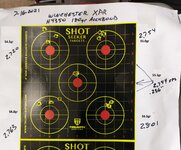Staff Member
Platinum Supporter
- Messages
- 9,729
- Reactions
- 15,459
I'm a self taught reloader. When I bought my first reloading equipment 30+ years ago the friend I bought it from gave me a quick rundown on how to work the process and handed me an old Lyman manual. I bought a new Hornady manual and cautiously started loading 41 Mag. After I didn't blow my gun or myself up, I progressed to other calibers and then bottle neck cartridges. I've learned several things the hard way, like squib loads (don't run 38 Special charges in a 357 Max case, even with soft lead bullets), over lubing cases, under lubing cases, etc. I've even "progressed" to fireforming for Improved cases and the old school method of sooting bullets to find the leade.
What I'm having a hard time wrapping my head around is ladder testing. Poking around the internet gives a few different ways to do it, but it seems like opinions on how to perform this testing, or it's actual value are widely different.
I get the jist of it, have a chronograph and a good place to shoot 100 yards, but not 300 like mentioned by some.
So, what can you guys teach me?
What I'm having a hard time wrapping my head around is ladder testing. Poking around the internet gives a few different ways to do it, but it seems like opinions on how to perform this testing, or it's actual value are widely different.
I get the jist of it, have a chronograph and a good place to shoot 100 yards, but not 300 like mentioned by some.
So, what can you guys teach me?














